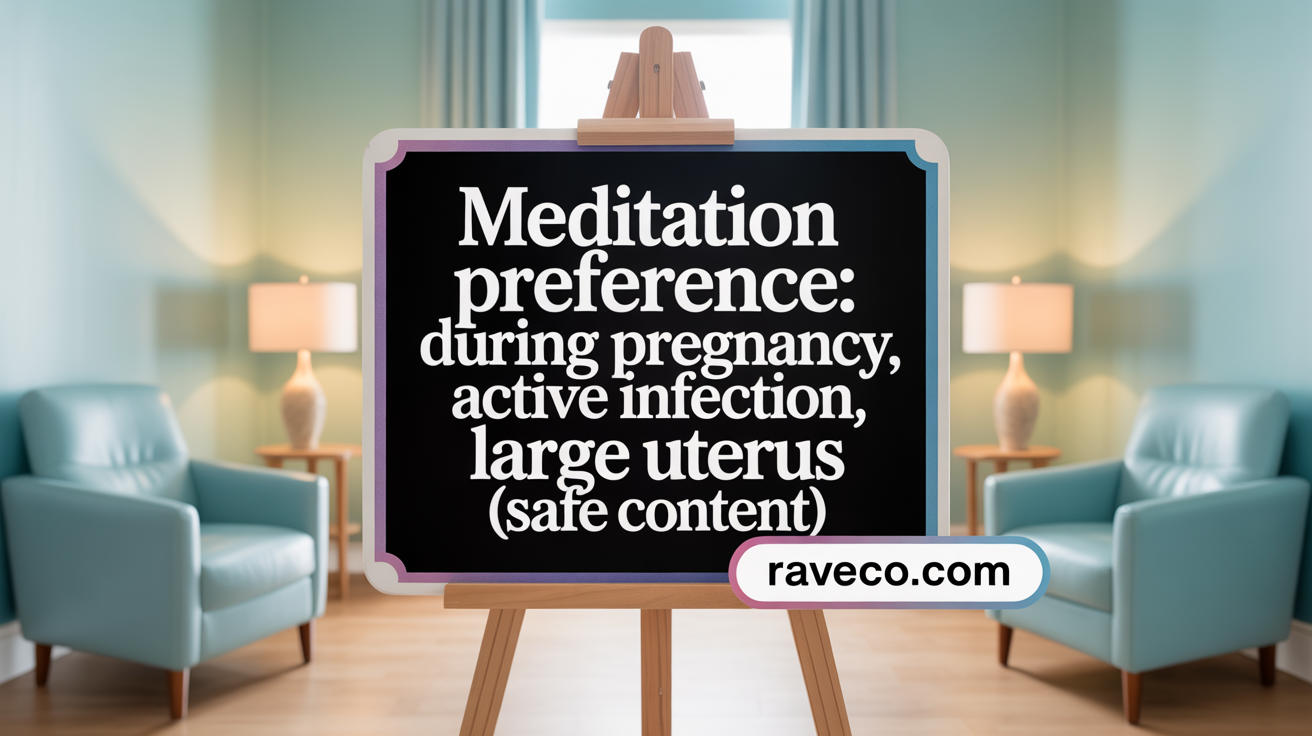Recognizing the Right Time to Address Female Infertility: Key Indicators and Expert Care in Queens

Understanding Treatment Choices for Heavy Menstrual Bleeding
Heavy menstrual bleeding can significantly disrupt daily life, leading women to seek effective treatments. While medication is often the first step, endometrial ablation presents a minimally invasive surgical option that can offer lasting relief when drugs fall short. This article explores the medical criteria, benefits, risks, and timing considerations involved in choosing endometrial ablation over medication for managing heavy or abnormal menstrual bleeding.
Medical Indications for Endometrial Ablation

What are the medical indications for performing endometrial ablation?
Endometrial ablation is mainly used to treat women who experience very heavy menstrual bleeding that disrupts daily life. The ideal candidates are women with bleeding so intense that they soak through a pad or tampon every two hours or less, or who have menstrual periods lasting longer than a week. Such heavy bleeding can cause anemia and affect overall health.
Typically, endometrial ablation is considered when medications, including hormonal birth control or pain medications, fail to control the bleeding or are not tolerated. Women often pursue this procedure when they want a less invasive alternative to hysterectomy, aiming to reduce or stop menstrual bleeding.
Women suitable for ablation do not have active pelvic infections, uterine abnormalities, or plans for future pregnancy. Most importantly, their uterine cavity should be of a size less than 10 cm, with no hyperplasia or malignancy detected on prior assessment. Successful ablation improves quality of life by alleviating heavy menstrual bleeding, making it a beneficial option for women seeking symptom relief without major surgery.
Patient profiles favoring endometrial ablation over medication
Patients who no longer wish to become pregnant or those who have not responded well to nonsurgical treatments often choose endometrial ablation. It offers advantages such as fewer complications, a faster recovery, and less postoperative discomfort compared to hysterectomy.
Women who are pre- or perimenopausal and experiencing disruptive bleeding, especially if bleeding interferes with daily activities or clothing choices, are also good candidates. The procedure is suitable for women with benign causes of heavy bleeding, such as fibroids smaller than 3 cm, provided they meet all other criteria.
Impact of heavy menstrual bleeding on quality of life
Heavy menstrual bleeding can significantly impair daily functions, emotional well-being, and intimacy. It often leads to frequent pad or tampon changes, discomfort, and anxiety about accidents or anemia. For many women, the symptoms reduce social participation and impact confidence.
By reducing menstrual volume or stopping bleeding altogether, endometrial ablation helps women regain control over their lives. It allows them to return to normal activities quickly, with lighter or absent periods being typical after the procedure.
Contraindications and Patient Factors That Favor Medication Over Ablation

What medical conditions make someone a poor candidate for endometrial ablation?
Certain health issues involving the uterus or endometrial tissue disqualify individuals from undergoing endometrial ablation. For example, uterine cancer is a primary contraindication because the procedure does not treat malignancies and could potentially delay necessary cancer management. Active pelvic or uterine infections are also contraindications, as performing ablation amidst such infections could worsen the condition or lead to complications.
Endometrial hyperplasia, particularly when atypical or suspected to be precancerous, requires different management strategies, making ablation unsuitable. Women who wish to preserve their fertility are generally advised against the procedure since ablation destroys the uterine lining, making future pregnancy unsafe or impossible.
What are the contra-indications for choosing endometrial ablation over medication?
There are specific situations where medication remains the preferred treatment option over ablation. If a woman is pregnant or planning pregnancy, endometrial ablation should be avoided because it hampers the ability to conceive and carries risks during pregnancy.
Active pelvic infections or other genital infections are clear contraindications, as any intervention could exacerbate infection or impair healing. Women diagnosed with uterine cancers, such as endometrial or cervical cancer, should not undergo ablation until the cancer is treated.
Large fibroids, uterine anomalies, or an enlarged uterus exceeding 10-12 cm in length often make the procedure more complex or unsafe. In addition, a woman with an intrauterine device (IUD), uterine prolapse, or cervical stenosis may face increased risks, including difficulty in performing the procedure or higher complication rates.
Prior uterine surgeries, especially those that weaken the uterine wall, also influence suitability. A comprehensive pre-procedural assessment, including ultrasound or hysteroscopy, helps assess these factors and guides treatment decisions.
Benefits and Risks: Ablation Compared to Medical Management
 Endometrial ablation offers an effective alternative to medication for women suffering from heavy menstrual bleeding that does not respond to initial treatments. It can significantly reduce menstrual flow, sometimes eliminating periods altogether, and is generally less invasive than more radical surgeries like hysterectomy. Patients often experience shorter recovery times, less postoperative pain, and can sometimes undergo the procedure in a doctor’s office rather than a hospital setting.
Endometrial ablation offers an effective alternative to medication for women suffering from heavy menstrual bleeding that does not respond to initial treatments. It can significantly reduce menstrual flow, sometimes eliminating periods altogether, and is generally less invasive than more radical surgeries like hysterectomy. Patients often experience shorter recovery times, less postoperative pain, and can sometimes undergo the procedure in a doctor’s office rather than a hospital setting.
However, this approach comes with certain downsides. About one in three women may need additional procedures within a few years, often due to incomplete tissue destruction or recurrent bleeding. Risks such as infection, uterine perforation, or thermal injury to surrounding tissues, although rare, are possible during the procedure.
In contrast, medication—like hormonal birth control or pain relievers—is non-invasive and can be adjusted or discontinued easily. It also allows for future pregnancy, which is not recommended after ablation. Yet, medications may be less effective for some women and can have systemic side effects such as weight gain, mood changes, or blood clot risks.
What are the benefits and risks associated with endometrial ablation compared to medication for heavy menstrual bleeding?
Endometrial ablation can effectively reduce menstrual bleeding, improving quality of life for many women, especially if medications fail or are poorly tolerated. It provides a quicker, less invasive option than hysterectomy, with fewer immediate complications.
Nevertheless, the long-term risks include the development of adhesions, recurrent bleeding, or condition-specific issues like worsening symptoms with fibroids or adenomyosis. There is also a chance of needing another surgery, including hysterectomy, within five years in about 25% of cases.
What are the typical side effects and long-term risks of endometrial ablation?
In the short term, women may experience cramping, vaginal spotting or bleeding, and pelvic discomfort. Long-term, potential complications include intrauterine adhesions (which can impair fertility), hematometra (blood buildup within the uterus), and incomplete destruction of the endometrial lining. Some women might develop scar tissue, which could lead to menstrual irregularities or fertility issues.
Other rare, but serious, risks involve abnormal blood collection in the fallopian tubes (PATSS), delayed cancer diagnosis, or the formation of scar tissue that can affect future pregnancies.
While generally safe, ongoing follow-up is essential to identify and manage any delayed or long-term adverse effects. These risks highlight the importance of careful patient selection and counseling prior to choosing endometrial ablation as a treatment option.
Appropriate Timing for Endometrial Ablation Over Medication
 Deciding when to proceed with endometrial ablation instead of continuing medication involves carefully evaluating several factors. First and foremost, the severity of the heavy menstrual bleeding (HMB) and its impact on the woman's daily life play a significant role. When bleeding persists unabated despite conservative treatments, or if the patient experiences soaking pads or tampons every two hours, it signals that medical management may no longer be sufficient.
Deciding when to proceed with endometrial ablation instead of continuing medication involves carefully evaluating several factors. First and foremost, the severity of the heavy menstrual bleeding (HMB) and its impact on the woman's daily life play a significant role. When bleeding persists unabated despite conservative treatments, or if the patient experiences soaking pads or tampons every two hours, it signals that medical management may no longer be sufficient.
The role of failed medical treatment is central in determining the timing for ablation. If hormonal therapies, NSAIDs, or hormonal IUDs do not alleviate symptoms or cause intolerable side effects, questioning the next step is warranted. Women who have exhausted options such as hormonal pills or IUDs, but still suffer from bothersome bleeding, are often considered ideal candidates for endometrial ablation.
Clinical evaluation before making the transition involves various assessments. Ultrasound, saline infusion sonogram, or hysteroscopy can reveal uterine size, shape, and presence of fibroids or polyps. Additionally, endometrial sampling ensures the absence of hyperplasia or malignancy, which would contraindicate ablation. Women with uterine anomalies, active infections, or large fibroids greater than 3 cm may not be suitable candidates.
Timing is optimized when noninvasive treatments have been tried and failed, and the patient's desire for future fertility has been addressed. As women over 40 often experience more stable menstrual patterns, age can influence the decision. Women should also be counseled on the implications, including that endometrial ablation impairs future fertility and should only be performed once they are certain they do not wish to conceive.
In practice, clinicians evaluate all these factors to identify the appropriate window for proceeding with ablation. The goal is to implement the procedure when it offers the best chance for symptom relief, minimal risks, and lasting benefits, after confirming that less invasive options have been exhausted and that patient selection criteria are met.
Ideal Candidates: Clinical Profiles Favoring Endometrial Ablation

Patient age and reproductive goals
Endometrial ablation is typically recommended for women of reproductive age who experience heavy menstrual bleeding that disrupts daily life. The procedure is especially suitable for women over 30 or 40, but younger women under 45 may be more prone to needing additional treatment in the future. Importantly, ablation is designed for women who no longer wish to become pregnant, as pregnancy afterward carries significant risks, including miscarriage, ectopic pregnancy, and complications for both mother and baby.
Uterine anatomy and pathology considerations
Candidates should have a uterine cavity length of less than 10 centimeters with a smooth contour. Women with uterine abnormalities such as large fibroids over 3 centimeters or severe uterine malformations are generally not suitable candidates. Prior cesarean sections or large myomectomies may result in thinner uterine walls, increasing surgical risks.
Quality of life impact and patient preferences
Women considering endometrial ablation often seek relief from heavy menstrual bleeding that affects daily activities, intimate life, or clothing choices. They typically have already tried or declined medication, such as hormonal birth control or pain relievers, and find these treatments ineffective or intolerable. This procedure offers a less invasive alternative to hysterectomy, with faster recovery and fewer complications.
Conditions suitable for ablation like small fibroids
Ablation can be effective when abnormal bleeding is due to benign causes. Women with small fibroids, less than 3 centimeters, can be considered suitable. It’s essential to confirm the absence of endometrial hyperplasia or cancer through prior sampling, usually via biopsy.
Factors predicting treatment success or failure
Success rates depend on several factors. Women older than 45, with fewer than five pregnancies, and no history of severe painful periods or tubal ligation tend to have better outcomes. Younger women under 45, especially with higher parity and pre-existing dysmenorrhea, are more likely to need additional interventions like hysterectomy. Preoperative assessments such as ultrasound or hysteroscopy help evaluate the uterine environment to predict the potential for successful treatment.
| Factor | Effect on Success | Additional Notes |
|---|---|---|
| Age over 45 | Higher success likelihood | Younger women, more chance of recurrence |
| Parity over 5 | Increased risk of treatment failure | Multiple pregnancies may affect uterine structure |
| Uterine size and shape | Smaller, normal-shaped uterine cavities | Larger or abnormal-shaped cavities less suitable |
| Uterine fibroids | Small (<3cm) fibroids acceptable; larger fibroids not | Larger fibroids may require other treatments |
| Endometrial pathology | No hyperplasia or malignancy confirmed | Routine biopsy recommended before procedure |
Overall, selecting appropriate candidates ensures the procedure’s effectiveness while minimizing risks, making thorough preoperative evaluation essential.
Procedural Overview and Postoperative Expectations
Ablation techniques and methods
Endometrial ablation utilizes various techniques to destroy the uterine lining and reduce heavy bleeding. These methods include radiofrequency, cryotherapy (freezing tissue), heated fluid, balloon thermal therapies, microwave energy, and electrosurgery. Each approach involves inserting a device through the cervix to target the endometrial tissue, with minimal invasiveness and often no need for incisions.
Outpatient setting and anesthesia options
Most endometrial ablation procedures are performed on an outpatient basis, meaning women can go home the same day. These procedures usually do not require general anesthesia; instead, local anesthesia or conscious sedation may be used for comfort. The minimally invasive nature of these techniques allows for quick recovery and reduced hospital stays.
Typical postoperative symptoms and recovery
After the procedure, women may experience cramping similar to menstrual pain, vaginal discharge, and increased urination. Menstrual periods often become lighter or stop altogether. Recovery generally includes rest at home, and most women return to daily activities within a few days. Mild discomfort and discharge can persist for weeks but gradually improve.
Necessity of continued gynecologic care post-procedure
Despite the changes brought by ablation, ongoing gynecologic care remains essential. Women should continue routine screenings such as pelvic exams, cervical cancer screening, and monitoring for any symptoms of concern. Regular follow-ups help ensure the health of the reproductive system and catch any potential issues early.
Contraception after ablation
Pregnancy after endometrial ablation is rare but possible and carries increased pregnancy-related risks. Therefore, women are strongly advised to use reliable birth control measures until menopause. This helps prevent unintended pregnancies that could lead to complications such as miscarriage, ectopic pregnancy, or fetal growth issues.
In summary, endometrial ablation offers a minimally invasive option for women seeking relief from heavy menstrual bleeding. Understanding the procedures, postoperative expectations, and the importance of ongoing gynecologic care and contraception helps ensure optimal outcomes.
Pregnancy and Fertility Considerations After Endometrial Ablation
Impact of ablation on fertility
Endometrial ablation is generally not recommended for women who wish to preserve their fertility. The procedure destroys the lining of the uterus, which can complicate future pregnancies. Women planning to conceive should consider alternative treatments.
Risks of pregnancy post-ablation
Pregnancies that occur after endometrial ablation carry higher risks for both mother and baby. These include increased likelihood of miscarriage, ectopic pregnancy, and complications during delivery. Due to changes in the uterine lining, pregnancies are considered high-risk.
Importance of contraception after procedure
Women who undergo endometrial ablation are advised to use reliable birth control measures. Since pregnancy is still possible and can be dangerous, ongoing contraception helps prevent unintended pregnancies and associated complications.
Counseling patients on fertility and pregnancy risks
Healthcare providers should thoroughly inform women about the reduced fertility and increased pregnancy risks following endometrial ablation. It’s important to discuss future pregnancy plans before the procedure and explore other options if pregnancy is desired in the future.
| Aspect | Consideration | Details |
|---|---|---|
| Fertility Impact | Not suitable for women wishing to conceive | The procedure destroys the uterine lining, impairing fertility |
| Post-Ablation Pregnancy Risks | Increased miscarriage and ectopic pregnancy | Pregnancies after ablation are at higher risk and require close monitoring |
| Contraceptive Needs | Essential to prevent pregnancy | Women should consistently use reliable birth control |
| Patient Counseling | Inform about risks and alternative options | Discussions should include future fertility desires and pregnancy risks |
Making an Informed Choice: Ablation Versus Medication
Choosing between endometrial ablation and medication for managing heavy or abnormal menstrual bleeding requires careful consideration of multiple factors including symptom severity, reproductive goals, uterine health, and treatment risks. Medication remains the initial approach due to its non-invasive nature and fewer immediate risks. However, when medical therapies fail, are contraindicated, or poorly tolerated, endometrial ablation offers an effective, less invasive alternative to hysterectomy with quicker recovery and high patient satisfaction. Ideal candidates are typically premenopausal women over 40 who have completed childbearing and have benign uterine anatomy without malignancy. Understanding contraindications and potential long-term risks facilitates safer treatment decisions. Ultimately, a collaborative approach between patient and healthcare provider, guided by thorough evaluation, ensures the best individualized care pathway for improving quality of life.
References
- Endometrial Ablation - ACOG
- Endometrial ablation - Mayo Clinic
- Endometrial Ablation - StatPearls - NCBI Bookshelf
- What Are the Different Types of Endometrial Ablation? - Cerene
- Endometrial ablation: A popular solution to abnormal bleeding for ...
- Endometrial Ablation - SASGOG Pearls of Exxcellence
- Surgery vs. Medical Therapy for Heavy Menstrual Bleeding - AAFP
- Endometrial ablation - Mayo Clinic
- Endometrial Ablation | Johns Hopkins Medicine





.png)